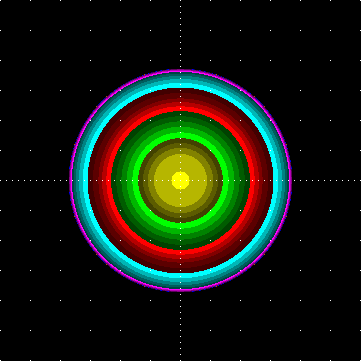


|

|
| In the left half of the left plot, specific illuminance by a continuous row of luminaires spaced 5 heights is shown (right half is for a single luminaire). | The right plot is for a single luminaire, unrotated. |

Values below the scale are illuminance / 1 lx. This is for (unrealistic) “unit” case that luminaires would have lamps producing 1 klm only, would be point-like and just 1 m over the terrain.
# IESNA91
# [TEST] GE 8451
# [MANUFAC] GE Lighting Systems - Hendersonville NC USA
# [LUMCAT] (not specific to a single catalog number)
# [LUMINAIRE] GE UNIGLOW 150 ENCL
# [LAMP] MET 100/U/MED
# [OTHER] Distribution: SC = 1.7
# [MORE] Socket Pos: D
# [MORE] Comments: - -
# [MORE] Revision No: 0 Rev Date: 980708 Test Date: 91010801
# [MORE] Reflector: 440011-01 Refractor: CLEAR FLAT GLASS
# TILT=NONE
# Bulbs: 1, 1000 lm each
# Number of measured angles: 37 vertical, 1 horizontal ones
# Photometric type: 1, Units type: 1
# Luminous opening diameter (and height?): 1.500 ( 0.000 )
# Ballast factor: 1, Input power: 0 W
# Source file: ies/ge8451.ies
# Luminaire flux = 789 lm,
# 78.9 % of the bulb flux
# between 75 and 90: 0.0 % of the luminaire flux
# - this part causes just GLARE in case of road lighting and similar purposes
# 80deg and above: max 0.0 cd/1000lm , 0.0 % of the luminaire flux
# 90deg and above: max 0.0 cd/1000lm , 0.0 % of the luminaire flux
# CutOff Type: Full_CutOff
# 62.5 deg to <67.5 deg: max 66 cd/1000lm,
# 67.5 deg to <72.5 deg: max 19 cd/1000lm,
# maximum spec. lum. intensity 306 cd/1000lm
# The following table gives luminous intensities which would be produced
# using a hypothetic bulb giving a luminous flux of 1000 lm (i.e., cd/klm):
0.0 240
5.0 239
10.0 245
15.0 239
20.0 208
25.0 197
30.0 228
35.0 274
40.0 306
45.0 291
50.0 224
55.0 161
60.0 119
65.0 66.0
70.0 19.0
75.0 0.0
80.0 0.0
85.0 0.0
90.0 0.0
95.0 0.0
100.0 0.0
105.0 0.0
110.0 0.0
115.0 0.0
120.0 0.0
125.0 0.0
130.0 0.0
135.0 0.0
140.0 0.0
145.0 0.0
150.0 0.0
155.0 0.0
160.0 0.0
165.0 0.0
170.0 0.0
175.0 0.0
180.0 0.0